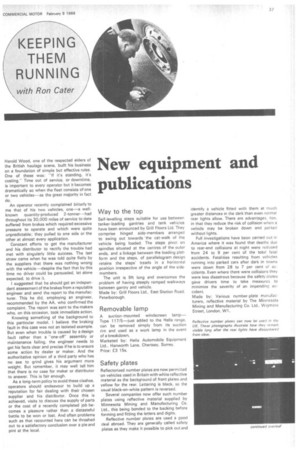New equipment and publications
Page 39

If you've noticed an error in this article please click here to report it so we can fix it.
Harold Wood, one of the respected elders of the British haulage scene, built his business on a foundation of simple but effective rules. One of these was: -If it's standing, it's costing." Time out of service, or downtime, is important to every operator but it becomes dramatically so when the fleet consists of one
or two vehicles as the great majority in fact do.
An operator recently complained bitterly to roe that of his two vehicles, one—a wellknown quantity-produced 2-tonner--had throughout its 30,000 miles of service to date suffered from brakes which required excessive pressure to operate and which were quite unpredictable: they pulled to one side or the other at almost every application.
Constant efforts to get the manufacturer and his distributor to rectify the trouble had met with singularly little success. The last straw came when he was told quite flatly by the suppliers that there was nothing wrong with the vehicle—despite the fact that by this time no driver could be persuaded, let alone expected, to drive it.
I suggested that he should get an independent assessment of the brakes from a reputable engineer and send the report to the manufacturer. This he did, employing an engineer, recommended by the AA, who confirmed the complaint. The report was sent to the makers who, on this occasion, took immediate action.
Knowing something of the background to this particular model, I believe the braking fault in this case was not an isolated example. But even when trouble is caused by a design Fault rather than a "one-off" assembly or maintenance failing, the engineer needs to get his facts clear and precise if he is to ensure some action by dealer or maker. And the authoritative opinion of a third party who has no axe to grind gives his argument more weight. But remember, it may well tell him that there is no case for maker or distributor to answer. This is fair enough.
As a long-term policy to avoid these clashes, operators should endeavour to build up a reputation for fair dealing with their chosen supplier and his distributor. Once this is achieved, visits to discuss the supply of parts or the cost of a recently completed job becomes a pleasure rather than a distasteful battle to be won or lost. And often problems such as that recounted here can be thrashed out to a satisfactory conclusion over a pie and pint at the local.
Way to the top
Self-levelling steps suitable for use between tanker-loading gantries and tank vehicles have been announced by Grill Floors Ltd. They comprise hinged side-members arranged to swing out towards 'the cat-walk of the vehicle being loaded. The steps pivot on spindles situated at the centres of the outer ends, and a linkage between the loading platform and the steps, of parallelogram design retains the steps' treads in a horizontal position irrespective of the angle of the sidemembers.
The unit is 9ft long and overcomes the problem of having steeply ramped walkways between gantry and vehicle.
Made by: Grill Floors Ltd., East Station Road, Peterborough.
Removable lamp
A suction-mounted windscreen lamp— Type 117/5—just added to the Hells range, can be removed simply from its suction rim and used as a work lamp in the event of a breakdown.
Marketed by: Hella Automobile Equipment Ltd., Hanworth Lane, Chertsey, Surrey.
Price: £3 15s.
Safety plates
Reflectorized number plates are now permitted ' on vehicles used in Britain with white reflective material as the background of front plates and yellow for the rear. Lettering is black, so the usual black-on-white pattern is reversed.
Several companies now offer such number plates using reflective material supplied by Minnesota Mining and Manufacturing Co. Ltd., this being bonded to the backing before forming and fitting the letters and digits.
Reflective number plates are used a good deal abroad. They are generally called safety plates as they make it possible to pick out and identify a vehicle fitted with them at much greater distances in the dark than even normal rear lights allow. There are advantages, too, in that they reduce the risk of collision when a vehicle may be broken down and parked without lights.
Full investigations have been carried out in America where it was found that deaths due to rear-end collisions at night were reduced from 24 to 9 per cent of the total fatal accidents. Fatalities resulting from vehicles running into parked cars after dark in towns were down from 28 to 7 per cent of accidents. Even where there were collisions they were less disastrous because the safety plates gave drivers time to take measures to minimize the severity of an impending accident.
Made by: Various number-plate manufacturers, reflective material by The Minnesota Mining and Manufacturing Co. Ltd„ Wigmore Street, London, Wl.




































































































